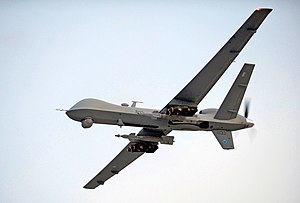
Back قتل مستهدف Arabic Cílené zabíjení Czech Gezielte Tötung German Asesinato selectivo Spanish قتل هدفمند Persian Assassinat ciblé French Ciljano ubijanje Croatian Նպատակային սպանություններ Armenian Pembunuhan yang ditargetkan ID Omicidio mirato Italian

Targeted killing is a form of assassination carried out by governments outside a judicial procedure or a battlefield.[1][2][3][4]
Since the late 20th century, the legal status of targeted killing has become a subject of contention within and between various nations. Historically, at least since the mid-eighteenth century, Western thinking has generally considered the use of assassination as a tool of statecraft to be illegal.[5] Some academics, military personnel and officials[6] describe targeted killing as legitimate within the context of self-defense, when employed against terrorists or combatants engaged in asymmetrical warfare. They argue that unmanned combat aerial vehicles (drones) are more humane and more accurate than manned vehicles.[7][8]
Scholars are also divided as to whether targeted killings are an effective counterterrorism strategy.[9][10][11][12][13][14]
- ^ Greenwald, Glenn (24 October 2012). "Obama moves to make the War on Terror permanent | Glenn Greenwald". The Guardian. ISSN 0261-3077. Retrieved 22 July 2019.
- ^ Pollack, Kenneth M. (7 March 2018). "Learning From Israel's Political Assassination Program". The New York Times. ISSN 0362-4331. Retrieved 22 July 2019.
- ^ Mann, James (14 June 2012). The Obamians: The Struggle Inside the White House to Redefine American Power. Penguin. p. 410. ISBN 9781101583616.
- ^ Lynn, John A. (23 July 2019). Another Kind of War: The Nature and History of Terrorism. Yale University Press. p. 410. ISBN 9780300188813.
- ^ Cite error: The named reference
CSSwas invoked but never defined (see the help page). - ^ "Targeted Killings". Council on Foreign Relations. Archived from the original on 10 February 2015. Retrieved 15 February 2015.
- ^ Carroll, Rory (2 August 2012). "The philosopher making the moral case for US drones". The Guardian. London. Archived from the original on 18 February 2017. Retrieved 16 December 2016.
- ^ Shane, Scott (14 July 2012). "The Moral Case for Drones". The New York Times. Archived from the original on 18 February 2017. Retrieved 13 February 2017.
- ^ Press, Stanford University (2019). Leadership Decapitation: Strategic Targeting of Terrorist Organizations | Jenna Jordan. Stanford University Press. ISBN 9781503608245. Retrieved 3 January 2020 – via www.sup.org.
- ^ Jordan, Jenna (April 2014). "Attacking the Leader, Missing the Mark: Why Terrorist Groups Survive Decapitation Strikes". International Security. 38 (4): 7–38. doi:10.1162/ISEC_a_00157. ISSN 0162-2889. S2CID 57569755.
- ^ Frankel, M. (2010). "The ABCs of HVT: Key Lessons from High Value Targeting Campaigns Against Insurgents and Terrorists". Studies in Conflict and Terrorism. 34: 17–30. doi:10.1080/1057610x.2011.531456. S2CID 110265235.
- ^ Jordan, Jenna (2 December 2009). "When Heads Roll: Assessing the Effectiveness of Leadership Decapitation". Security Studies. 18 (4): 719–755. doi:10.1080/09636410903369068. ISSN 0963-6412. S2CID 59496454.
- ^ Johnston, Patrick B. (1 April 2012). "Does Decapitation Work? Assessing the Effectiveness of Leadership Targeting in Counterinsurgency Campaigns". International Security. 36 (4): 47–79. doi:10.1162/ISEC_a_00076. ISSN 0162-2889. S2CID 53519659.
- ^ Price, Bryan C. (1 April 2012). "Targeting Top Terrorists: How Leadership Decapitation Contributes to Counterterrorism". International Security. 36 (4): 9–46. doi:10.1162/ISEC_a_00075. ISSN 0162-2889. S2CID 15188795.